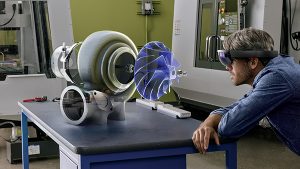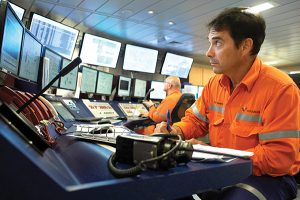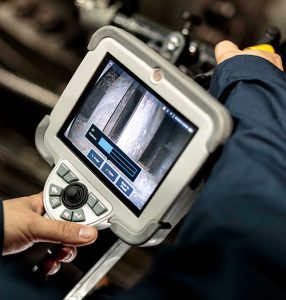The next frontier is harnessing artificial intelligence to revolutionize mining
The technology is IBM’s Watson cognitive analytics, known more colloquially as artificial intelligence or AI and soon to be applied to Goldcorp’s Red Lake mine in Ontario. There, Watson will ingest, analyze and synthesize massive amounts of complex geological and survey data, says Goldcorp’s Vice-President Technology Luis Canepari, signalling a potential sea change in mining and minerals exploration analytics.
“It’s similar to what happened in the oil and gas industry when fracking was discovered. That completely reshaped the way oil and gas was explored.”

Microsoft’s HoloLens technology places holographic images over physical
structures, creating a mixed reality. CREDIT: MICROSOFT
IBM will tell you Watson has had nearly the same revolutionary effect on oil and gas exploration, assisting Woodside Energy’s assessments of how oil and gas platforms respond to extreme weather off Western Australia’s North West Shelf, and helping Spain’s Repsol do the same, but also evaluate external threats to drilling, such as the cultural and political climates of a region.
But according to IBM’s oil and gas clients, Watson’s most impressive feat, says IBM Director of Cognitive and Analytics Solutions Development Dariusz Piotrowski, is “how to think like an engineer, but then teach them how to think like thousands of engineers.” That’s AI’s real power, says Piotrowski. “They’re systems that learn, rather than systems that are merely programmed.” “And it’s Watson’s ability to interact with experts that is such an important part of solution development,” says Piotrowski. IBM’s hope is to place the same power that helped oil and gas into the hands of miners and prospectors.

Woodside, an Australian oil and gas company, uses IBM Watson to enhance decision making and increase efficiencies. CREDIT: WOODSIDE.
Older and even wiser IBM Watson works by combining disparate sources of knowledge typically found at most properties or exploration zones: geological and drilling data, drilling reports, surveys, historical information, and the reams of internal data contained in process logs, reports, and studies. Watson then synthesizes those massive amounts of data with the knowledge older geologists and engineers have accumulated from years of field experience. This, in turn, says Piotrowski, will enable them and a whole new generation of geologists to pose questions to Watson, along with its recommendations for minerals exploration.
“Watson allows geologists to interpret subsurface information and make predictions as to where the gold might be.” Geologists are not bound by Watson’s predictions, however. Instead, they provide Watson feedback on its predictions and recommendations so that it learns over time what works and what doesn’t.

GE’s Mentor Visual iQ Video Borescope with 3D Measurement. CREDIT: GE
“That’s half of the learning process,” says Piotrowski.
Just how accurate are Watson’s predictions? Well, if the oil and gas industry’s use of Watson is any indication, very accurate.
“Depending on whether it was gas or oil we’ve seen prediction accuracy improving from sixty or seventy per cent to more than ninety per cent,” Piotrowski says.
Whether mining can achieve similar results may be answered at Goldcorp’s Red Lake facility this summer. There, geologists will assess Watson’s ability to accurately determine successive exploration targets and help teams locate gold deposits previous drilling campaigns failed to find. If Watson performs as promised, the end result could be higher yields along with less environmental impact.
Certainly that’s what Canepari is hoping for. But he believes Watson may be helpful in another way, by directing the company’s attention back to previous areas of exploration which failed to produce expected results. “The data may tell you to look back and redrill some of those areas and discover if you missed something.”
Watson’s primary purpose, however, is to identify fresh indicators in previously unknown gold resources that
may also be subject to expert bias experienced geologists bring to older, unproductive properties. The key to Watson’s ultimate acceptance by those same experts, says Piotrowski, will be the logic and rationale underpinning Watson’s recommendations, giving them added confidence to make faster, more data-driven decisions.
Get more out of what you have “The machine alone or talented individual alone is not as powerful or as effective as a strong process with a strong machine and the individual to benefit from that.” That’s how Vice-President of APM Product Management at GE Digital Jeremiah Stone summarizes work on AI done by Andrew McAfee and Erik Brynjolfsson at MIT on the effects of machine learning on industry and society. Machine and man must work together.
To make that tangible, Stone uses the example of how a haul truck performs in the field and GE’s empirical, machine learning model of the same truck, which tells you how that haul truck ought to be performing. GE calls this specific class of AI “similarity- based modelling,” constructed from historical data for an individual piece of equipment, and then overlaid with real-time sensoring data to provide an eye into the future for operations and maintenance planning.
Like Watson, GE’s “digital twin” continually refines itself for each asset it builds, becoming “a higher and higher fidelity representation of a physical asset in the field,” says Stone. The longer you run the analytics and the more data you bring in, the better the guidance provided operations management becomes. “You have fewer false positives and higher performance when applying analysis on that digital twin.”
All that data, whether it’s the direct sensor and control system data or the analytic data derived from the digital twin, belongs to the customer, adds Stone. “And if an operator wants a site specific infrastructure with their own room and their own engineers doing the analysis, we provide that. We have customers who have gone that route.”
All of this will have miners questioning whether they want to add more mechanical capacity at site when they might be able to get more capacity out their existing, deployed assets via the introduction of analytics, machine learning and AI. Straining the capex with a new ball mill and circuit may not always be the way to go when attempting to increase the ratio of metal to tailings, says Stone.
“I may be able to achieve my target production with improvements to my controls technology in the form of real-time, feed forward and feedback loop processing where we have analytics embedded directly in the mineral processing.”
Another question surrounds the degree of change management that has to occur when integrating existing process controls with cognitive analytics, which take advantage of the internet-based Cloud or customer data centre. No one wants to take down capital equipment in order to make a major change and lose a month of production and money better spent elsewhere.
GE’s solution, says Richard Carpenter, general manager of control platforms in automation and controls, has been to develop its technology in two pieces. One is development of the next generation of controls technology. The second is standalone IoT (Internet of Things) devices placed next to existing systems which act as the data concentration and collector point.
“These bring information to the cloud infrastructure where the analytics can be done,” says Carpenter. “Being able to run these things in parallel with existing systems, between cycles, really helps the client start to make use of that technology sooner.”
We’re in this together
IBM won’t be alone at Red Lake. Microsoft has worked with Goldcorp in the past using machine learning algorithms to predict the location of additional exploration targets and locate undiscovered gold deposits. And this summer its Cortana Analytics Suite will be in head-to-head competition with Watson, says Microsoft Industry Solutions Executive Mark Speaker.
“It’s to help geologists make better decisions. So you’d have a number of screens on which you can view the ore body. You look at the results from numerically and visual based algorithms to determine ‘Hey is this the right spot to go after?’”
Like GE’s “digital twin,” Microsoft cognitive analytics places digital imaging over physical structures, creating a digital copy of mining assets. The difference is these are holographic images, a “mixed reality” product called HoloLens that enables staff to visualize the use of IoT to pull data from the process control systems and the creation of a hierarchical equipment structure.
“But unlike some competitors who see images in two dimensions on a flat screen, our customers see images in three and four dimensions,” says Speaker, the fourth dimension consisting of scenarios played out over time. “So, for example, if you want to see what happened on a mine site over the past five years you can play that in a holographic scenario just like you would play a movie and see that activity happen.”
Generational change
Last July, Microsoft also announced its collaboration with GE to make its Predix platform available on the Microsoft Azure cloud, capturing intelligence from its machines and other industrial assets.
That includes natural language technology, artificial intelligence, advanced data visualization and enterprise application integration – all part of an effort to simplify business processes and “re-imagine” how work gets done, GE CEO Jeff Immelt said at the time.
And how might an industry with its feet planted firmly on the ground and still somewhat skeptical about such technology respond? Richard Carpenter says general acceptance may be a function of demographic and generational change. Many geologists and site managers have forty plus years of knowledge and experience but they are starting to retire, making way for the “digital” generation.
“That combination is what’s going to drive the future, where the knowledge is captured in a way that can be used coming into these industries, without the same level of experience as the people who are retiring,” Carpenter notes.
David Godkin is a freelance writer based in Toronto.
Comments
Mike Candid
Artificial intelligence will have a huge impact on the oil and gas industry, as well. AI would be able to use predictive algorithms to balance grids, negotiate joint actions to self-heal networks in case of bugs or hacks, and to assess the reliability of production and consumption figures created by producer-consumers….we’re in store for an exciting future